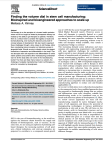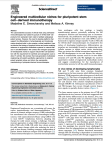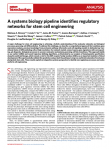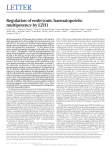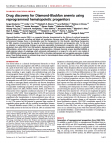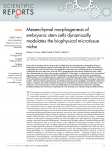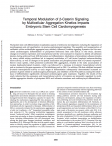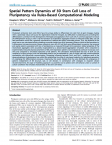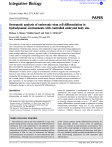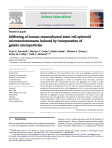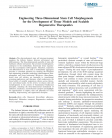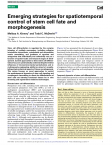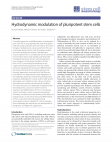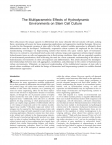read our previous work
primary Research
Finding the volume dial in stem cell manufacturing: Bioinspired and bioengineered approaches to scale up
Kinney MA
Cell therapy is on the precipice of a human health revolution where we will no longer be limited by therapeutic efficacy but instead by the ability to get therapies to patients. Therefore, there is a critical need to consider the logistics of scale and biomanufacturing, even during the discovery and proof-of-concept phases of development. We also need to approach these challenges through a lens unique to cell therapy, rather than constraining future innovation on historical success in tangential fields. Should we aim to directly mimic the elegant hierarchies of expansion and differentiation in the body? Can we decouple stem cell expansion and differentiation to rewire native systems and achieve other manufacturing constraints? Can we let the body take over some of the manufacturing burden? As there are likely many routes to a solution, the challenge of scalable manufacturing of stem cell therapies is prime for innovation by bioengineers.
Engineered multicellular niches for pluripotent stem cell-derived immunotherapy
Smerchansky ME, Kinney MA
The unprecedented success of clinical trials using cell-based immunotherapies has fueled the pursuit of ‘off-the-shelf’ cell products from pluripotent stem cells to facilitate widespread patient access. However, the need to develop platforms that support the differentiation of phenotypically and functionally mature lymphoid cells in vitro remains a critical roadblock. Here we discuss the biology of lymphoid niches and review enabling advances in engineered multicellular systems for natural killer and T cell differentiation. We contrast the emergent properties of hematopoietic niches to support natural killer cell specification with the requirement for synthetic and xenogeneic cues to direct T cell fate. We envision that next-generation multicellular engineering will exploit quantitative approaches to engineer potent lymphoid niches and inform the reproducible manufacturing of pluripotent-derived immunotherapies.
A systems biology pipeline identifies regulatory networks for stem cell engineering
Kinney MA, Vo LT, Frame JM, Barragan J, Conway AJ, Li Si, Wong K, Collins JJ, Cahan P, North TE, Lauffenburger DA, Daley GQ.
A major challenge for stem cell engineering is achieving a holistic understanding of the molecular networks and biological processes governing cell differentiation. To address this challenge, we describe a computational approach that combines gene expression analysis, previous knowledge from proteomic pathway informatics and cell signaling models to delineate key transitional states of differentiating cells at high resolution. Our network models connect sparse gene signatures with corresponding, yet disparate, biological processes to uncover molecular mechanisms governing cell fate transitions. This approach builds on our earlier CellNet and recent trajectory-defining algorithms, as illustrated by our analysis of hematopoietic specification along the erythroid lineage, which reveals a role for the EGF receptor family member, ErbB4, as an important mediator of blood development. We experimentally validate this prediction and perturb the pathway to improve erythroid maturation from human pluripotent stem cells. These results exploit an integrative systems perspective to identify new regulatory processes and nodes useful in cell engineering.
Lin28 and let-7 Regulate the Timing of Cessation of Murine Nephrogenesis
Yermalovich A, Osborne Jk, Sousa P, Han A, Kinney MA, Chen M, Robinton D, Montie H, Pearson D, Wilson S, Combes A, Little M, Daley GQ.
In humans and in mice the formation of nephrons during embryonic development reaches completion near the end of gestation, after which no new nephrons are formed. The final nephron complement can vary 10-fold, with reduced nephron number predisposing individuals to hypertension, renal, and cardiovascular diseases in later life. While the heterochronic genes lin28 and let-7 are well-established regulators of developmental timing in invertebrates, their role in mammalian organogenesis is not fully understood. Here we report that the Lin28b/let-7 axis controls the duration of kidney development in mice. Suppression of let-7 miRNAs, directly or via the transient overexpression of LIN28B, can prolong nephrogenesis and enhance kidney function potentially via upregulation of the Igf2/H19 locus. In contrast, kidney-specific loss of Lin28b impairs renal development. Our study reveals mechanisms regulating persistence of nephrogenic mesenchyme and provides a rationale for therapies aimed at increasing nephron mass.
Regulation of haematopoietic multipotency by EZH1
Vo LT, Kinney MA, Liu X, Zhang Y, Sousa PM, Barragan J, Jha DK, Cesana M, Shao Z, Orkin SH, Doulatov S, Xu J, Daley GQ.
All haematopoietic cell lineages that circulate in the blood of adult mammals derive from multipotent haematopoietic stem cells (HSCs). By contrast, in the blood of mammalian embryos, lineage-restricted progenitors arise first, independently of HSCs, which only emerge later in gestation. As best defined in the mouse, ‘primitive’ progenitors first appear in the yolk sac at 7.5 days post-coitum. Subsequently, erythroid–myeloid progenitors that express fetal haemoglobin, as well as fetal lymphoid progenitors, develop in the yolk sac and the embryo proper, but these cells lack HSC potential. Ultimately, ‘definitive’ HSCs with long-term, multilineage potential and the ability to engraft irradiated adults emerge at 10.5 days post-coitum from arterial endothelium in the aorta-gonad-mesonephros and other haemogenic vasculature. The molecular mechanisms of this reverse progression of haematopoietic ontogeny remain unexplained. We hypothesized that the definitive haematopoietic program might be actively repressed in early embryogenesis through epigenetic silencing, and that alleviating this repression would elicit multipotency in otherwise lineage-restricted haematopoietic progenitors. Here we show that reduced expression of the Polycomb group protein EZH1 enhances multi-lymphoid output from human pluripotent stem cells. In addition, Ezh1 deficiency in mouse embryos results in precocious emergence of functional definitive HSCs in vivo. Thus, we identify EZH1 as a repressor of haematopoietic multipotency in the early mammalian embryo.
Drug discovery for Diamond Blackfan Anemia using reprogrammed hematopoietic progenitors
Doulatov S, Vo LT, Macari ER, Wahlster L, Kinney MA, Taylor AM, Barragan J, Gupta M, McGrath K, Lee H-Y, Humphries JM, DeVine A, Narla A, Alter BP, Beggs AH, Agarwal S, Ebert BL, Gazda HT, Lodish HF, Sieff CA, Schlaeger TM, Zon LI, Daley GQ.
Diamond-Blackfan anemia (DBA) is a congenital disorder characterized by the failure of erythroid progenitor differentiation, severely curtailing red blood cell production. Because many DBA patients fail to respond to corticosteroid therapy, there is considerable need for therapeutics for this disorder. Identifying therapeutics for DBA requires circumventing the paucity of primary patient blood stem and progenitor cells. To this end, we adopted a reprogramming strategy to generate expandable hematopoietic progenitor cells from induced pluripotent stem cells (iPSCs) from DBA patients. Reprogrammed DBA progenitors recapitulate defects in erythroid differentiation, which were rescued by gene complementation. Unbiased chemical screens identified SMER28, a small-molecule inducer of autophagy, which enhanced erythropoiesis in a range of in vitro and in vivo models of DBA. SMER28 acted through autophagy factor ATG5 to stimulate erythropoiesis and up-regulate expression of globin genes. These findings present an unbiased drug screen for hematological disease using iPSCs and identify autophagy as a therapeutic pathway in DBA.
Mesenchymal morphogenesis of embryonic stem cells dynamically modulates the biophysical microtissue niche
Kinney MA, Saeed R, McDevitt TC.
Stem cell fate and function are dynamically modulated by the interdependent relationships between biochemical and biophysical signals constituting the local 3D microenvironment. While approaches to recapitulate the stem cell niche have been explored for directing stem cell differentiation, a quantitative relationship between embryonic stem cell (ESC) morphogenesis and intrinsic biophysical cues within three-dimensional microtissues has not been established. In this study, we demonstrate that mesenchymal embryonic microtissues induced by BMP4 exhibited increased stiffness and viscosity accompanying differentiation, with cytoskeletal tension significantly contributing to multicellular stiffness. Perturbation of the cytoskeleton during ESC differentiation led to modulation of the biomechanical and gene expression profiles, with the resulting cell phenotype and biophysical properties being highly correlated by multivariate analyses. Together, this study elucidates the dynamics of biophysical and biochemical signatures within embryonic microenvironments, with broad implications for monitoring tissue dynamics, modeling pathophysiological and embryonic morphogenesis and directing stem cell patterning and differentiation.
Temporal modulation of B-catenin signaling by multicellular aggregation kinetics impacts embryonic stem cell cardiomyogenesis
Kinney MA, Sargent CY, McDevitt TC.
Pluripotent stem cell differentiation recapitulates aspects of embryonic development, including the regulation of morphogenesis and cell specification via precise spatiotemporal signaling. The assembly and reorganization of cadherins within multicellular aggregates may similarly influence β-catenin signaling dynamics and the associated cardiomyogenic differentiation of pluripotent embryonic stem cells (ESCs). In this study, dynamic changes in β-catenin expression and transcriptional activity were analyzed in response to altered cell adhesion kinetics during embryoid body (EB) formation and differentiation. Modulation of intercellular adhesion kinetics by rotary orbital mixing conditions led to temporal modulation of T-cell factor/lymphoid enhancer-binding factor activity, as well as changes in the spatial localization and phosphorylation state of β-catenin expression. Slower rotary speeds, which promoted accelerated ESC aggregation, resulted in the early accumulation of nuclear dephosphorylated β-catenin, which was followed by a decrease in β-catenin transcriptional activity and an increase in the gene expression of Wnt inhibitors such as Dkk-1. In addition, EBs that exhibited increased β-catenin transcriptional activity at early stages of differentiation subsequently demonstrated increased expression of genes related to cardiomyogenic phenotypes, and inhibition of the Wnt pathway during the initial 4 days of differentiation significantly decreased cardiomyogenic gene expression. Together, the results of this study indicate that the expression and transcriptional activity of β-catenin are temporally regulated by multicellular aggregation kinetics of pluripotent ESCs and influence mesoderm and cardiomyocyte differentiation.
Spatial Pattern Dynamics of 3D Stem Cell Loss of Pluripotency via Rules-Based Computational Modeling
White DE, Kinney MA, McDevitt TC, Kemp ML.
Pluripotent embryonic stem cells (ESCs) have the unique ability to differentiate into cells from all germ lineages, making them a potentially robust cell source for regenerative medicine therapies, but difficulties in predicting and controlling ESC differentiation currently limit the development of therapies and applications from such cells. A common approach to induce the differentiation of ESCs in vitro is via the formation of multicellular aggregates known as embryoid bodies (EBs), yet cell fate specification within EBs is generally considered an ill-defined and poorly controlled process. Thus, the objective of this study was to use rules-based cellular modeling to provide insight into which processes influence initial cell fate transitions in 3-dimensional microenvironments. Mouse embryonic stem cells (D3 cell line) were differentiated to examine the temporal and spatial patterns associated with loss of pluripotency as measured through Oct4 expression. Global properties of the multicellular aggregates were accurately recapitulated by a physics-based aggregation simulation when compared to experimentally measured physical parameters of EBs. Oct4 expression patterns were analyzed by confocal microscopy over time and compared to simulated trajectories of EB patterns. The simulations demonstrated that loss of Oct4 can be modeled as a binary process, and that associated patterns can be explained by a set of simple rules that combine baseline stochasticity with intercellular communication. Competing influences between Oct4+ and Oct4− neighbors result in the observed patterns of pluripotency loss within EBs, establishing the utility of rules-based modeling for hypothesis generation of underlying ESC differentiation processes. Importantly, the results indicate that the rules dominate the emergence of patterns independent of EB structure, size, or cell division. In combination with strategies to engineer cellular microenvironments, this type of modeling approach is a powerful tool to predict stem cell behavior under a number of culture conditions that emulate characteristics of 3D stem cell niches.
Systematic analysis of embryonic stem cell differentiation in hydrodynamic environments with controlled embryoid body size
Kinney MA, Saeed R, McDevitt TC.
The sensitivity of stem cells to environmental perturbations has prompted many studies which aim to characterize the influence of mechanical factors on stem cell morphogenesis and differentiation. Hydrodynamic cultures, often employed for large scale bioprocessing applications, impart complex fluid shear and transport profiles, and influence cell fate as a result of changes in media mixing conditions. However, previous studies of hydrodynamic cultures have been limited in their ability to distinguish confounding factors that may affect differentiation, including modulation of embryoid body size in response to changes in the hydrodynamic environment. In this study, we demonstrate the ability to control and maintain embryoid body (EB) size using a combination of forced aggregation formation and rotary orbital suspension culture, in order to assess the impact of hydrodynamic cultures on ESC differentiation, independent of EB size. Size-controlled EBs maintained at different rotary orbital speeds exhibited similar morphological features and gene expression profiles, consistent with ESC differentiation. The similar differentiation of ESCs across a range of hydrodynamic conditions suggests that controlling EB formation and resultant size may be important for scalable bioprocessing applications, in order to standardize EB morphogenesis. However, perturbations in the hydrodynamic environment also led to subtle changes in differentiation toward certain lineages, including temporal modulation of gene expression, as well changes in the relative efficiencies of differentiated phenotypes, thereby highlighting important tissue engineering principles that should be considered for implementation in bioreactor design, as well as for directed ESC differentiation.
Stiffening of human mesenchymal stem cell spheroid microenvironments induced by incorporation of gelatin microparticles
Baraniak PR, Cooke MT, Saeed R, Kinney MA, Fridley KM, McDevitt TC.
Culturing multipotent adult mesenchymal stem cells as 3D aggregates augments their differentiation potential and paracrine activity. One caveat of stem cell spheroids, though, can be the limited diffusional transport barriers posed by the inherent 3D structure of the multicellular aggregates. In order to circumvent such limitations, polymeric microparticles have been incorporated into stem cell aggregates as a means to locally control the biochemical and physical properties of the 3D microenvironment. However, the introduction of biomaterials to the 3D stem cell microenvironment could alter the mechanical forces sensed by cells within aggregates, which in turn could impact various cell behaviors and overall spheroid mechanics. Therefore, the objective of this study was to determine the acute effects of biomaterial incorporation within mesenchymal stem cell spheroids on aggregate structure and mechanical properties. The results of this study demonstrate that although gelatin microparticle incorporation results in similar multi-cellular organization within human mesenchymal stem cell spheroids, the introduction of gelatin materials significantly impacts spheroid mechanical properties. The marked differences in spheroid mechanics induced by microparticle incorporation may hold major implications for in vitro directed differentiation strategies and offer a novel route to engineer the mechanical properties of tissue constructs ex vivo.
Hydrodynamic modulation of embryoid body differentiation by rotary orbital suspension culture
Sargent CY, Berguig GY, Kinney MA, Carpenedo RL, Hiatt LA, Berson RE, McDevitt TC.
Embryonic stem cells (ESCs) can differentiate into all somatic cell types, but the development of effective strategies to direct ESC fate is dependent upon defining environmental parameters capable of influencing cell phenotype. ESCs are commonly differentiated via cell aggregates referred to as embryoid bodies (EBs), but current culture methods, such as hanging drop and static suspension, yield relatively few or heterogeneous populations of EBs. Alternatively, rotary orbital suspension culture enhances EB formation efficiency, cell yield, and homogeneity without adversely affecting differentiation. Thus, the objective of this study was to systematically examine the effects of hydrodynamic conditions created by rotary orbital shaking on EB formation, structure, and differentiation. Mouse ESCs introduced to suspension culture at a range of rotary orbital speeds (20-60 rpm) exhibited variable EB formation sizes and yields due to differences in the kinetics of cell aggregation. Computational fluid dynamic analyses indicated that rotary orbital shaking generated relatively uniform and mild shear stresses (< or =2.5 dyn/cm(2)) within the regions EBs occupied in culture dishes, at each of the orbital speeds examined. The hydrodynamic conditions modulated EB structure, indicated by differences in the cellular organization and morphology of the spheroids. Compared to static culture, exposure to hydrodynamic conditions significantly altered the gene expression profile of EBs. Moreover, varying rotary orbital speeds differentially modulated the kinetic profile of gene expression and relative percentages of differentiated cell types. Overall, this study demonstrates that manipulation of hydrodynamic environments modulates ESC differentiation, thus providing a novel, scalable approach to integrate into the development of directed stem cell differentiation strategies.
Review Articles
Engineering three-dimensional stem cell morphogenesis for the development of tissue models and scalable regenerative therapeutics
Kinney MA, Hookway TA, Wang Y, McDevitt TC
The physiochemical stem cell microenvironment regulates the delicate balance between self-renewal and differentiation. The three-dimensional assembly of stem cells facilitates cellular interactions that promote morphogenesis, analogous to the multicellular, heterotypic tissue organization that accompanies embryogenesis. Therefore, expansion and differentiation of stem cells as multicellular aggregates provides a controlled platform for studying the biological and engineering principles underlying spatiotemporal morphogenesis and tissue patterning. Moreover, three-dimensional stem cell cultures are amenable to translational screening applications and therapies, which underscores the broad utility of scalable suspension cultures across laboratory and clinical scales. In this review, we discuss stem cell morphogenesis in the context of fundamental biophysical principles, including the three-dimensional modulation of adhesions, mechanics, and molecular transport and highlight the opportunities to employ stem cell spheroids for tissue modeling, bioprocessing, and regenerative therapies.
Emerging strategies for spatiotemporal control of stem cell fate and morphogenesis
Kinney MA and McDevitt TC.
Stem cell differentiation is regulated by the complex interplay of multiple parameters, including adhesive intercellular interactions, cytoskeletal and extracellular matrix remodeling, and gradients of agonists and antagonists that individually and collectively vary as a function of spatial locale and temporal stages of development. Current approaches to direct stem cell differentiation focus on systematically understanding the relative influences of microenvironmental perturbations and simultaneously engineering platforms aimed at recapitulating physicochemical aspects of tissue morphogenesis. This review focuses on novel approaches to control the spatiotemporal dynamics of stem cell signaling and morphogenic remodeling to direct the differentiation of stem cells and develop functional tissues for in vitro screening and regenerative medicine technologies.
Hydrodynamic modulation of pluripotent stem cells
Fridley KM, Kinney MA, McDevitt TC.
Controlled expansion and differentiation of pluripotent stem cells (PSCs) using reproducible, high-throughput methods could accelerate stem cell research for clinical therapies. Hydrodynamic culture systems for PSCs are increasingly being used for high-throughput studies and scale-up purposes; however, hydrodynamic cultures expose PSCs to complex physical and chemical environments that include spatially and temporally modulated fluid shear stresses and heterogeneous mass transport. Furthermore, the effects of fluid flow on PSCs cannot easily be attributed to any single environmental parameter since the cellular processes regulating self-renewal and differentiation are interconnected and the complex physical and chemical parameters associated with fluid flow are thus difficult to independently isolate. Regardless of the challenges posed by characterizing fluid dynamic properties, hydrodynamic culture systems offer several advantages over traditional static culture, including increased mass transfer and reduced cell handling. This article discusses the challenges and opportunities of hydrodynamic culture environments for the expansion and differentiation of PSCs in microfluidic systems and larger-volume suspension bioreactors. Ultimately, an improved understanding of the effects of hydrodynamics on the self-renewal and differentiation of PSCs could yield improved bioprocessing technologies to attain scalable PSC culture strategies that will probably be requisite for the development of therapeutic and diagnostic applications.
The multi-parametric effects of hydrodynamic environments on stem cell culture
Kinney MA, Sargent CY, McDevitt TC.
Stem cells possess the unique capacity to differentiate into many clinically relevant somatic cell types, making them a promising cell source for tissue engineering applications and regenerative medicine therapies. However, in order for the therapeutic promise of stem cells to be fully realized, scalable approaches to efficiently direct differentiation must be developed. Traditionally, suspension culture systems are employed for the scale-up manufacturing of biologics via bioprocessing systems that heavily rely upon various types of bioreactors. However, in contrast to conventional bench-scale static cultures, large-scale suspension cultures impart complex hydrodynamic forces on cells and aggregates due to fluid mixing conditions. Stem cells are exquisitely sensitive to environmental perturbations, thus motivating the need for a more systematic understanding of the effects of hydrodynamic environments on stem cell expansion and differentiation. This article discusses the interdependent relationships between stem cell aggregation, metabolism, and phenotype in the context of hydrodynamic culture environments. Ultimately, an improved understanding of the multifactorial response of stem cells to mixed culture conditions will enable the design of bioreactors and bioprocessing systems for scalable directed differentiation approaches.
Melissa A. Kinney, Ph.D.
Department Of Biomedical Engineering
University Of Wisconsin-Madison
Engineering Centers Building
Room 2148
1550 Engineering Dr
Madison, WI 53706


